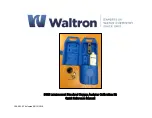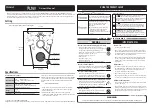
FMX-003_UM_9752020820_NL_D_GB_F_V2_0 27
GB
USER'S MANUAL FOR FMX-003
1. Introduction
Read this manual completely before you put this product into use.
Follow the instructions set out in this manual to ensure proper operation of the product and to
be able to invoke guarantee.
The guarantee terms are stated in the General Conditions for the Sale and Delivery of Products
and/or Performance of Activities by SIMCO (Nederland) B.V.
2. Safety
The FMX-003 is intended for use in areas that are free of water, oil, solvents and other
conductive contaminants. Exposure to such contaminants will cause failure of the electrical
insulation system in the product. Formulation of dew on the fieldmeter must be avoided.
Do not insert any object in the opening for the sensor located at the measuring side of the
instrument; no foreign substance should ever enter into the sensor opening.
Do not operate near corrosive fumes of acid/alkali or corrosive gases such as chlorine.
Do not use the FMX-003 in a fire and/or explosion hazardous environment.
If changes, adjustments, etc. have been made without prior consent in writing, the instrument
loses its CE-approval and guarantee.
Repairs shall be made by a skilled electrical engineer.
This equipment must have proper earth reference for accurate measurements.
3. Use and operation
The FMX-003 is an accurate electrostatic fieldmeter for tracing and measuring electrostatic
charges. It can be used to establish if and where (discharge) anti-static bars must be fitted. Due
to its compact design it is possible to perform measurements in difficult spots. POWER on/off,
ZERO adjustment, Ion Balance (IB) and HOLD are all push button operations. The HOLD
button allows the display to retain the static charge reading. This is especially useful where the
display is difficult to see during measurement. The static charge is detected by the measuring
probe and processed by a microcomputer and can be read on a display. The FMX-003 meas-
ures static voltages /- 20kV at a distance of 25mm. Distance indication LED's facilitate
the establishment of the measuring distance.
















































